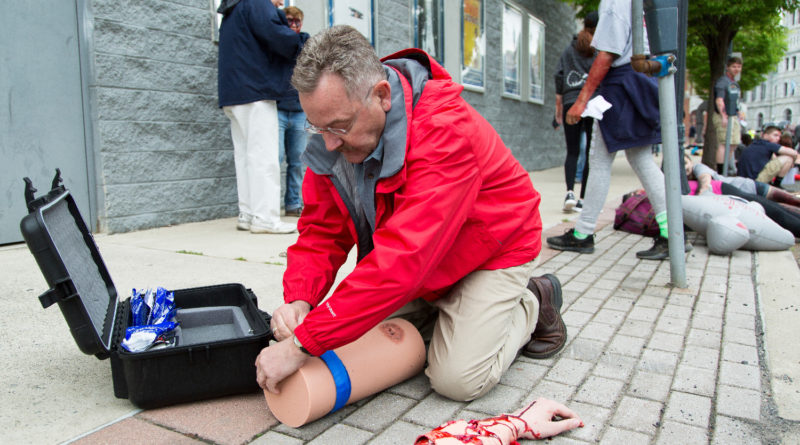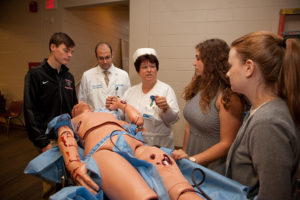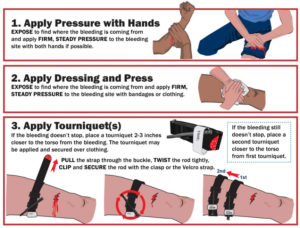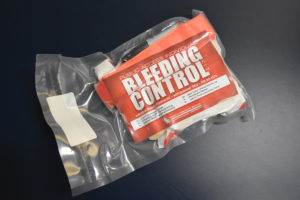Experts share tips on how to stop the bleed, save a life
Coreen Levan didn’t know what to expect when she responded to a frantic call from her cousin and renter Melinda LeBarron, asking for help after a bear attack on Dec. 12.
“When I first saw her, I said, ‘Oh, my God!’ The first thing I saw was white skull where the bear scalped her, and then all the blood,” she said. “It was everywhere. On the floor, on the couch, on the walls.”
Levan’s adrenaline took over, ushering her young grandson to another room and grabbing the phone to call 911.
“I told them my cousin had been attacked by a bear and she was scalped and there was blood everywhere,” she said. “I told them they needed to get there right away.”
Fortunately, the bleeding from LeBarron’s many wounds had slowed on its own, and according to Geisinger Medical Center’s Deb Erdman, reaching out to emergency services quickly can be critical in cases with excessive blood loss.
“If you see someone with an excessive bleeding problem, you need to get EMS involved, but you also need to address the bleed quickly — especially if there is spurting, pumping or oozing of blood,” she said.
“Adults only have about five or six liters of blood in them, and if they lose as much as you’d picture fitting into a soda can, the patient can get woozy and go into shock.”
Quick response
How do you slow or stop the bleeding?
“We don’t want people to get too hung up on major vs. moderate vs. minor bleeds — if you can put direct pressure over the wound and it stops it, that’s great,” said Tony Bixby, director of prehospital services at UPMC Susquehanna. “If the blood soaks through the dressing, add another on top — don’t take off the old dressing — and keep applying direct pressure.”
If the bleed continues, don’t hesitate to consider a tourniquet.
“There was a fear in the past that you’d cut off circulation to the arm or leg and if the tourniquet is on too long, that the arm or leg may need to be amputated,” Bixby said. “Recent studies, however, have shown that a tourniquet applied directly can be on longer than you’d expect before it causes longterm damage.”
Dr. B. James Connolly, medical director for emergency services at Evangelical Community Hospital, agreed.
“A lot of what we know about treatment of wounds comes from battlefield situations — we’ve learned quite a bit, especially in the Persian Gulf wars. Soldiers would have potentially survivable wounds where uncontrolled bleeding was the cause of death,” he said. “We’ve learned that you can leave a properly placed tourniquet on for four hours without longterm effect to the tissue. However, a tourniquet is going to hurt when applied properly. If you use one, it needs to be applied and then left on until emergency personnel can handle it.”
Tourniquets should be applied high on an arm or leg according to Annalisa Negrea, injury prevention coordinator for acute care with UPMC Susquehanna.
“You have two bones in each of your lower arms and lower legs, but only one in the upper arms and legs,” she said. “It is easier to compress things around the one bone.”
Tourniquet debate
Medical professionals debated the improvisation of tourniquets.
“Most common, you see things like a belt or a tie or any piece of clothing being used. Clothing can be tricky because when it gets soaked in blood, it naturally loosens,” he said. “Ultimately, if you are talking life or death, you can’t be too tricky. The goal is to keep tightening down until the bleeding stops.”
Connolly, however, urged against improvising a tourniquet.
“You hear stories of people using shoelaces or other item, but they don’t work as well and can cause additional damage,” he said. “We encourage people to take a Stop the Bleed course and keep a kit nearby. There are professionally developed tourniquets in them that work. We recommend against even buying tourniquets on Amazon because we’ve found there to be a lot of knock-offs, and they can cause issues.”
Erdman agreed that it is not advisable to improvise a tourniquet.
“If you don’t have a combat application tourniquet, the recommendation is to keep using pressure. You don’t need to use a clean dressing if you don’t have one. Use a towel or T-shirt and don’t worry about it being sterile — we’ll deal with the wound when the patient gets to the hospital,” she said. “When all is said and done, you can’t give antibiotics to a dead person. The goal is to keep the six liters in the body, not on the floor.”
Which is why timing and quick response is key to successful first aid response, Bixby added, suggesting that severe arterial bleeds can drain a body of blood in three to five minutes.
“That is why we need to teach even the lay person the importance of direct pressure and tourniquets — even when you call 911, it can take a couple minutes to get the call in and dispatch a unit. All told, it can take a decent amount more than three to give minutes for emergency personnel to get on the scene.”
Determining which type of vessel the blood is coming from can be a matter of color.
“Venous blood is darker in color and typically oozes out of the wound. Veins are typically closer to the surface of the skin and there isn’t as much oxygen as it travels back to the heart,” Bixby said. “Classic arterial bleeds are a bright red spurting — there is much more pressure since this blood is coming right out of the heart.”
Build a barrier
When handling blood and other bodily fluids, there can be a fear of cross-contamination of illnesses such as HIV or hepatitis, and while it is important to be mindful and take whatever precautions as possible, Negrea suggested not underestimating the barrier properties of your own skin.
“As long as you don’t have any cuts or abrasions on your skin, it can be a very effective protective barrier,” she said. “We’d obviously encourage anyone to take whatever precautions they can and to wash their hands thoroughly afterward.”
Precautions, according to Erdman, can include improvising with whatever you can find around you.
“You can’t get HIV or hepatitis C by blood getting on your skin, but obviously, the more layers you can put between yourself and the blood, the better,” she said. “Use a sandwich bag, a chip bag or anything else to create an extra barrier. You don’t need to go out and buy gloves and keep them on you at all times — the key in these situations is acting quickly.”
Connolly encourages everyone to invest in a Stop the Bleed kit — which includes protection in the form of gloves.
“It has an official tourniquet, gloves and even combat gauze you can put on the wound to help increase clotting,” he said. “It has everything you’d need to safely treat these type of wounds.”
In addition, Connolly recommends everyone get the Stop the Bleed training — especially those who are in situations where there could be “mass casualty events,” such as schools, workplaces and churches.
“Let’s say the Lewisburg school had an event — everyone is quick to say that it is just down the road from the hospital and everyone would be able to get the help they need right away,” he said. “We have a great emergency response team, but it is scattered around the region. If there was a mass casualty event, our resources would be quickly overwhelmed.
“Dealing with a bleeding wound can require prompt care, and can safely be done with minimal training and the right tools. Take the time to take the training and get the kits — it can definitely save a life.”




